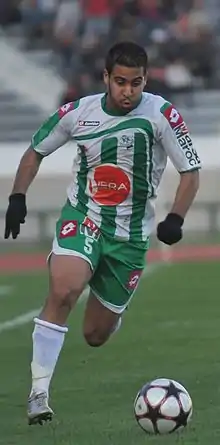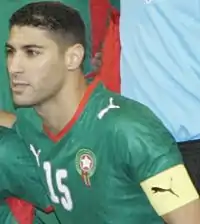Raja CA
Raja Club Athletic (Raja CA or RCA) or simply known as Raja (Arabic: نادي الرجاء الرياضي, romanized: Nādī ar-Rajāʾ ar-Riyāḍī) is a Moroccan professional football club based in Casablanca, that competes in Botola, the top tier of Moroccan football, which they never got relegated from. Regarded as one of the greatest clubs in the african continent, the club has domestically won twelve League titles, and eight Throne Cups. In international competitions, the club has won three CAF Champions Leagues, one Confederation Cup, one CAF Cup, two CAF Super Cups, one Afro-Asian Club Championship, one Arab Club Champions Cup, and one North African cup.
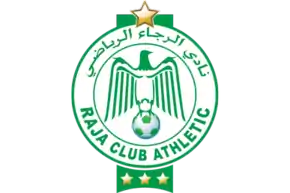 | ||||
| Full name | Raja Club Athletic نادي الرجاء الرياضي | |||
|---|---|---|---|---|
| Nickname(s) |
| |||
| Short name | Raja CA, RCA | |||
| Founded | 20 March 1949 | |||
| Ground | Stade Mohamed V Casablanca, Morocco | |||
| Capacity | 67,000 | |||
| President | Rachid Andaloussi | |||
| Head coach | Jamal Sellami | |||
| League | Botola | |||
| 2019–20 | 1st of 16 (champions) | |||
| Website | Club website | |||
|
| ||||
Founded on 20 March 1949 by Moroccan nationalists and Syndicalists in the popular district of Derb Sultan,[1][2] Raja CA is a well known club for the success of its football section, very popular in and outside the country. Raja sits at the Raja-Oasis Sports center for training, and plays matches at Stade Mohammed V since 1955.
Raja CA is one of the biggest football clubs of the continent, it is the only Arab team, with Al Ain FC, to reach the final of the FIFA Club World Cup in 2013. In 2000, Raja was placed by FIFA in 10th place in the ranking of the best clubs in the world after their performances at the 2000 Clubs World Cup, and was ranked by CAF in the 3rd place of the best African clubs of the 20th century, after Al Ahly SC and Zamalek SC. Raja is also, with 17 trophies, the most successful Moroccan club of the 21st century. Nowadays, Raja is the 5th most crowned club in Africa with 8 titles in official competitions.
Most popular club in the country,[3] and designated by MARCA as the most popular of the continent,[4] Raja has long-standing rivalries with certain teams, so as Wydad AC, this intense confrontation between the two teams is known as the Casablanca Derby.[5] The Green Eagles displays superiority over their rivals both in terms of victories and goals.
Rachid Andaloussi has been acting president of the club since 14 December 2020, after the resignation of Jawad Ziyat. Former player Jamal Sellami is the head coach since 11 November 2019.
History
Raja Club Athletic (abbreviated to Raja CA or RCA) was founded on 20 March 1949 by the Moroccan resistance and more particularly by the honorary president Moulay Sassi Ben Ahmed El Alaoui Aboudarka and the heads of the Moroccan unions, in particular the first president of the Moroccan Workers' Union, Mahjoub Ben Seddik, as well as the former president of the Union of Arab Lawyers and ex-prime minister Mohamed Maâti Bouabid.
Boujemaa Kadri took charge of the administrative organization, necessary for the foundation of Raja CA. Other personalities are behind the club's creation, such as Tibari, Salah Medkouri, Mustapha Chemseddine, Karim Hajjaj, Si Ahmed Skalli Haddaoui, Choukri, Daoudi, Hachmi Nejjar, Mohamed Charfaoui, Laachfoubi El Bouazzaoui, Abdelkader Jalal, Naoui, and some other Moroccan intellectuals and resistance fighters who met often at a cafe named Al Watan (The Country in english), owned at the time by Hmidou El Watani, in Derb Sultan.
The ban on entrusting the presidency of the club to a Moroccan is circumvented by leaving the chair for six months to Ben Abadji Hejji, a Muslim of Algerian origin who had the French nationality. The French authorities, are thus forced to accept that. After several attempts to find a name for the club, a draw between the names of Raja and Fath, allowed the name Raja, picked three consecutive times, to be chosen.
The beginnings after independence (1956–1973)

After the independence of Morocco in 1956, the Royal Moroccan Football Federation is created and therefore replaces one of the twenty-two leagues of the French Football Federation during the time of the French Protectorate which was called Ligue du Maroc de Football. For its first season, the FRMF receives the affiliations of 310 clubs and 6,087 player licensees. The criterium replaced the championship and had to lead to play-offs, each team having to play three matches and gain as many victories to reach the elite. Raja successively beats in its group the Sports Union of Ben Ahmed 4–1, Ennasr of Casablanca on the score of 2–0 (goals of Moussa and Acila) and finally Olympique Ouezzane on score of 7–0 with 4 goals scored by Hamid Bahij. Raja was thus the first team to enter the first division because the last game was played at 8:30 a.m. Kacem Kacemi then retired from his coaching position for personal reasons. Raja CA lost the first match disputed in the first division championship against Fath Union Sport (2–0), but they managed to beat SC Roches Noires in the next leg with a score of 2–0. The team finishes the season at the tenth position, barely avoiding relegation. The following year, thanks to the arrival of Affani Mohamed Ben Lahcen known as "Père Jégo", the club finished fourth.
During the 1959–1960 season, a huge controversy broke out at the end of the season after the Moroccan federation decided to play a triangular tournament between the first three teams of the tied championship in terms of points while Raja was in the lead with goal difference. The club refused protested this unfair decision and refused to participate and the tournament was transformed into a play-off between FAR Rabat and KAC Kénitra. KAC won the game and the title while Raja was ranked third. The team's forward Moussa Hanoune was crowned as the league's top scorer with 22 goals, a record at the time.

In 1964–1965, if the club finished twelfth and almost got relegated, he still managed to qualified for the Throne Cup final for the first time in its history, where it faced Kawkab of Marrakech on 13 June 1965 at Stade Mohammed V. KACM won the match 3–1 and the only goal scored by Raja was scored by Bhaija. It was the third consecutive coronation of the Merrakchis in the competition, and the first defeat in the Raja final. During this season, the Greens defeated Wydad in the quarterfinals with a score of two to one.
The team finished the 1966–1967 season in third place in the championship with 65 points, while Raja's and the national team striker Houmane Jarir finished top scorer with 18 goals.
On 14 July 1968 at the Stade d'honneur, the final of the Throne Cup took place, between Raja and Racing de Casablanca. RAC won the title for the first time in its history and the Eagles, still unable to claim their first title, lost on the score of 1–0.
Three cups in a decade (1973–1982)
The 1974 Throne Cup final opposed the semi-final winners, Raja who beat Wydad AC on penalties, against the Maghreb de Fès who eliminated Mouloudia Oujda. During a match played in the Stade Mohammed V on 28 July 1974, Raja led by coach Mohammed Tibari, wins the cup against MAS thanks to the goal of El Arabi (1–0). The Green Eagles won this competition for the first time and also won the first title in their history.
On 17 July 1977, Raja CA moved to Rabat to face Difaâ Hassani El Jadidi at the Stade du FUS on behalf of the Throne Cup final. The Greens won the match 1–0 on a penalty from Abdellatif Beggar and therefore won the competition for the second time.
In 1980–1981, the Raja finished third in the championship, then fifth in 1981–1982, however, the Greens did not go out empty-handed this season. On 14 March 1982 at the Stade Roches Noires in Casablanca, the final of the Throne Cup was played between Raja and the Renaissance of Kenitra. And as in 1977, it was the late Abdellatif Beggar who scored the only goal of the match, and offered Raja his third title in the competition.
This season will also witness the first appearance of Raja on the African scene, more precisely in the 1983 African Cup Winners' Cup, by opposing on the first round to AS Police, the Greens lost in Senegal (1–0), and do not manage to catch up with the return match in Casablanca which ends with a draw (0–0). Thus, Raja CA, a team still inexperienced in continental competitions, was eliminated in the first round.
First titles in Africa and Morocco (1982–1995)
In 1982–1983, the Raja again finished fifth in the championship, and reached the final of the Throne Cup for the second time in a row, this time against the Olympique de Casablanca. The final took place on 21 August 1983 at the Stade Mohamed V, Raja loses the title this time on penalties (4–5), after the match ended in a draw (1–1).
Raja finished second in the 1985–1986 championship, behind his rival Wydad AC, who edged him 2 points on the last day. Furthermore, he was eliminated in the cup by the future champion, AS Far in the round of 16 (2–0).
This year will also see the consecration of the Moroccan national team in the 1986 World Cup. Led by the captain of Raja Abdelmajid Dolmy, the Moroccans were the first African team to reach the knockout stages before losing to West Germany (1–0) on a goal by Lothar Matthäus in the 87th minute. From Dolmy, we will keep the image of this excellent No. 6 who, during the Morocco - England game, amazed the crowds and was noted 9/10 by the newspaper L’Équipe.
In the 1987–1988 season, then coached by the Portuguese Fernando Cabrita, Raja defeated US Sidi Kacem (1–0) on the penultimate day thanks to the goal of Abderrahim Hamraoui. The Greens finally manage to win their first championship title after 39 years.
Following this, Raja participates in the 1989 African Cup of Clubs, the Eagles of Rabah Saâdane wrap up this edition by winning in the final against the Algerian side of MC Oran on penalties after a cumulative score of 1–1. Raja succeeds in winning this competition from its first participation.
In 1990–1991, the team finished ninth in the championship, and was eliminated in the quarterfinals of the Throne cup by KAC Kénitra. The following season, Raja finished second 8 points behind Kawkab Marrakech, and managed to climb to the Throne cup final face Olympique de Casablanca again. The match took place on 11 January 1993 at the El Harti Stadium in Marrakech and Olympique managed to beat Raja another time in the final with a score of 1–0.
Raja finished another time in second place in 1992–93 Botola behind Wydad. In the Throne Cup, Raja finally manage to beat Olympique de Casablanca before being eliminated in the semi-finals by Kawkab of Marrakech.
Supremacy (1995–2006)

Unlike its two most serious competitors, who won a lot of titles in the 1950s and the 1970s for Wydad and the 1960s and 1980s for the FAR, the Rajaouis have been revealing themselves since the end of the 1980s. Raja has won 3 titles since its creation, the supporters had to wait almost forty years, precisely the year of 1988 to see their team crowned as champion of Morocco.
In early 1995, it is announced that Olympique de Casablanca will be dissolved by its owner, ONA Group, due to financial problems, some of its players joined Raja (Jrindou, Sellami..), and some others have left for other teams or have retired. Between 1995 and 2002, Raja became the team to beat which won a record of six championship titles in a row. This auspicious period culminated in 1999 when Raja established itself as the best African team with victories in the CAF Champions League, African Super Cup and Afro-Asian Cup.
On 18 February 1996, in the quarterfinals of the 1995-96 Throne Cup, Raja recorded the highest score in the history of Derby and overpowered Wydad (5–1), goals of Sellami and two goals from Nazir and Khalif. He then eliminated Rachad Bernoussi in the semi-finals (3–0) before defeating ASFAR in the final with a goal scored by Jrindou in the 119th minute.
Two months later, and three days before the end of the championship, Guennadi Rogov's players won the title by 9 points ahead of Olympique Khouribga. Green Eagles won their first domestic double and the third of Moroccan football history.
On 16 September 1996, Raja lost the final of the 1996 Arab Club Champions Cup, organized in Egypt, against Al Ahly SC at the Cairo International Stadium with a score of 3–1.
On 15 June 1997, and after a tough title race with Wydad, Raja, led by Alexandru Moldovan, secure the second League Titlechampionship in a row two days from the end, with 2 points ahead of their rival.
On 14 December 1997, and after losing the first leg against Ashanti Gold S.C. (1–0), the Green Eagles won their second Champions League title, first edition under this new name, on penalties after winning the match (1–0) thanks to Nazir's goal in the 79th minute.
On 15 March 1998 at Stade Mohammed V, Raja lost the African Super Cup to Étoile du Sahel on penalties after regulation time ended on a draw (2–2).
On 3 May, Raja defeated Hassania Agadir and won the Championship with a record of 67 points and one loss conceded, an all-time record also. On November 8, despite their victory over Manning Rangers (2–1), the Greens Eagles were eliminated from the semi-finals of the 1998 Champions League, finishing 3rd in their group behind Manning Rangers and the future champions, ASEC Abidjan.
On 25 April 1999 at Stade Mohamed V, the Greens won the Afro-Asian Cup against the Korean side Pohang Steelers following the goal of Zakaria Aboub (1–0), after a 2-2 in Pohang, (goals of Moustawdaa and Khalif) in Pohang.
On 29 June 1999, under the direction of Oscar Fulloné, Raja defeated JS Massira (2–1) and won his 4th League title in a row with a total of 62 points, still closely followed by the Kawkab Marrakech.

In the second leg of the 1999 Champions League final, and after a draw at Stade Père Jégo (0–0), Fulloné's men face Espérance Sportive de Tunis at Stade El Menzah. In the first minutes, the referee offers an unfair penalty to the Tunisian side and a red card to captain Abdellatif Jrindou who then gave his armband to Moustawdaa. The penalty was finally stopped by Mustapha Chadli, and with 10 players on the pitch, the game stayed goalless (0–0). Then came the penalty shootout, and the success of Chadli who stopped the last penalty and offered the title to his team and the qualification for the World Cup.
Raja is the first Arab and African club to qualify for the Club World Championship, organized in Brazil. Raja is eliminated from the first round after three defeats against S.C Corinthians (0–2), Al Nassr FC (3–4, goals by Nejjary, Bouchaib El Moubarki and El Karkouri) and Real Madrid (2–3, goals by Achami and Moustawdaa). This last game where Raja made a memorable performance against the Club of the Century, but lost on a late goal of Geremi, offers the team huge admiration by the press and warm cheers by the public present at the Estádio do Morumbi.
On 5 March 2000, in a full and enthousiastic Stade Mohammed V, Raja beat the Ivorian side Africa Sports thanks to the goals of Bouchaib El Moubarki and Mohamed Armoumen (2–0) and won its first CAF Super Cup after the one lost in 1998. On 21 June, after their victory against JS Massira (4–1), the Eagles set a new record and won their 5th championship in a row with 59 points, ahead of Wydad and Maghreb de Fès.
On 20 May 2001, the formation of Silvester Takač defeated Kawkab (1–0), and aligned the 6th consecutive championship with a total of 64 points. On 27 May, Raja is eliminated for the second consecutive time from the quarter-finals of the Champions League, despite his victory over TP Mazembe in Casablanca (2–1), after his defeat in Lumumbashi on the score of 2–0.
On 17 November 2002, in a memorable match, the Green Devils overcomes a 2–0 first-leg deficit by beating ASEC Abidjan in the semi-finals at Mohamed V. Raja thus enters its 4th Champions League final to face Zamalek SC. After a draw (0–0) in Casablanca, Walter Meeuws' men were defeated in Cairo (0–1). It's the first loss of a Champions League final, after their victories in 1989, 1997 and 1999.

At the end of the 2002–2003 championship, the team finished in the second position 2 points behind Hassania Agadir. Mustapha Bidoudane was crowned top scorer with a total of 14 goals, the last Rajaoui to win this trophy was Houmane Jarir in 1967.
On 9 November 2003 at Stade Roumdé Adjia, Henri Michel's men won the CAF Cup against the Cameroonian side of Cotonsport (0–0), after their 2–0 first leg victory thanks to the goal of Bidoudane and Ali Diallo. It is the last edition of this competition before it was merged with the African Cup Winners' Cup to create the CAF Confederation Cup,Raja thus obtains the right to keep this trophy.
On 11 January 2004, Raja won the Throne Cup for the 5th time in its history by beating MAS of Fez with the score of 2–0, following the goals of Soulaimane and Bidoudane. On 25 April, the Green Eagles are eliminated from the knockout stages of the Champions League. At the Moulay Abdellah stadium, the Raja defeated ASC Jeanne d'Arc on the score 2–0 (goals of Misbah and Bidoudane), but conceded a defeat in Dakar on the same result. The shots on goal offered the qualification to the Senegalese team (5–4).
On 20 June, Raja was crowned champion of Morocco for the 8th time in its history after defeating the KAC Kénitra with the score of 4–1.
On 16 July 2005 at the Moulay Abdallah stadium, Raja won the 5th throne cup, beating Olympique Khouribga on penalties (5–4) in the final after a 0-0 draw.
In the round of 16 of the Arab Champions League, Zamalek SC beat Raja in Rabat 2–0, but the Greens manage to overcome the deficit in the seconde leg, by winning 3–0 in Cairo thanks to the goals of Maïga, Alloudi and Iajour. Raja won the competition by beating ENPPI Club in the final with respective scores of 2–1 and 1–0. In the league, the club finished in 4th position, it's the team's worst ranking since 1995.
Swinging results (2006–2012)
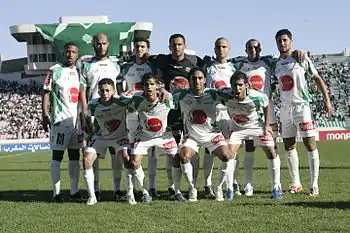
In the 2006 transfer window, Raja had to faca a wave of departure of important players such as Merouane Zemmama, Modibo Maïga or the scorer of the previous season, Mustapha Bidoudane. There followed a catastrophic season which ended with an eleventh place in the League and an elimination in the quarterfinals of the Throne cup.
During the following season, despite the difficult times, Jean-Yves Chay young promoted players managed to secure a third place in the championship, and even managed to win the Derby on both legs on the respective scores of 2-0 and 1-0.
In 2008–2009, the club separated from Jean-Yves Chay and replaced him with Portuguese José Romão. Reinforcing the squad with a few old and young players, Raja returns to lift the national trophy after 5 years. The following season, and on the final day, they needed a victory in Rabat against the AS FAR to be champions, but Ouaddouch's goal preclude that, and offered the title to Wydad. After an early elimination in the Champions League the same year, President Rhallam's policy is highly criticized and he ends up resigning after a mediocre season.
In the summer of 2010, the return of ex-president Abdesalam Hanat was highly greeted by supporters, and, after a mass recruitment of new players (Mahdoufi, Koné, Berrabeh ...) and former players (El Moubarki, Erbati, Aboucherouane ...). Raja were crowned Champions of Morocco with 7 points ahead of his runner-up, adding a 10 league titles star on the badge.
On 28 January 2011, Raja registered the highest score of its participation in the Champions League by beating Tourbillon FC 10–1. He then qualified for the quarter-finals of the competition by defeating ASEC Mimosas, after the match was played in single phase in Casablanca because of Second Ivorian Civil War.
Boudrika era (2012–2016)
After a large wave of protest, President Abdesalam Hanat resigns from his post and a general assembly is scheduled for June 2012. Mohamed Boudrika was then elected president, and former player and coach of the team, M'hamed Fakhir is back on the bench, and promised a renewal both at the administrative and sporting levels with the recruitment of a high number of players.
The club begins the pre-season preparation in Tunisia and then returns to Morocco to face Athletic Bilbao where 60,000 supporters are eager to see the new face of their team. Raja beat the finalists of the Europa League and Copa del Rey 3–1 (Mouhcine Moutouali, Adil Karrouchy and Mouhcine Iajour), then loses in Tangier against FC Barcelona of Lionel Messi with the highest score conceded in the history of the team 8–0.
On 18 November at the Moulay Abdellah stadium, the players won the 7th Throne Cup of the history of the club against AS FAR following a penalty shootout after regulation time ended in a 0-0 draw.
On 3 April 2013, the Greens were eliminated from the semi-finals of the Arab Cup against Al-Arabi SC by conceding a draw at Stade Al Abdi 2–2 despite having led the score thanks to the double from Moutouali. The first leg in Kuwait ended in a 1–1 draw.
On 25 May, after an epic match against Difaâ Hassani El Jadidi, Raja are champions of Morocco for the 11th time, after dominating the championship all season, and breaking the record for goals scored (56 goals).
On 18 November, Raja qualify for the Throne cup final for the second consecutive time, but lost the title on penalties against DHJ El Jadida, despite having been a favorite. Adding this to the bad results in the league, and few days before the World Cup, te club decides to dismiss M'hamed Fakhir's, and appoints the Tunisian Faouzi Benzarti in his place.
From 11 to 21 December 2013, Raja participated for the second time in its history in the FIFA Club World Cup. The Greens eliminated Auckland City (2–1), C.F. Monterrey (2–1) and Atlético Mineiro (3–1). to get to the final, a stage never reached by an Arab or a North African team. The team lost in the final 2–0 against Bayern Munich but came out proud with the applause of the supporters and the international press which praised this achievement. Raja is then greeted upon his arrival in Casablanca by King Mohamed VI who pays tribute to them during a ceremony at the royal palace where he decorate the entire team. The achievement becomes one of the greatest exploits in the history of Moroccan, African and Arab football.
In 2013–2014, after a poor first leg which ended with the departure of M'hamed Fakher, Faouzi Benzarti relaunched the green machine, result: Raja garnered 35 points out of 45 possible, scored 30 goals and only cashed 6. During the penultimate day, and in a packed Mohammed V stadium, the Greens played the title and confronted the leader, Moghreb Tétouan. With a Mitouali at the top of his game which scored twice, Raja won 5–0. The team moves favorite on the final day to Safi to face the local team and must win the game to secure the title. But to everyone's surprise, the Olympic Club de Safi scored a goal that would deprive them of the title and offer it to MAT.
The 2014–2015 season is one of the most deplorable one in the history of the club, Raja finishes the championship in 8th place, is eliminated from the knockout stages of the Throne Cup, in the eighths of Champions League final against ES Setif on penalties after an epic return match in Algeria (cumulative score: 4–4).
Nonetheless, the team managed to win the 2015 UNAF Club Cup in this critical period after beating Club Africain 2-0, Egypt's Ismaily SC, and a draw against Al Hilal Benghazi.
Crisis (2016–2018)
After the departure of Mohamed Boudrika at the end of the 2015–2016 season, the new president Said Hasbane declares that Raja suffers from a financial crisis, so it must find solutions by bringing in new sponsors.
On 10 August, the Raja thanked Rachid Taoussi for his services and appointed M'hamed Fakhir as coach, who makes his comeback to command the greens for the third time after 2010 and 2012. At the end of the season, the team finishes the championship in the third place despite being close to winning the title, before yielding the first and second place to Wydad and Difaâ El Jadida.
In the summer of 2017, financial problems got worse and supporters demanded the departure of the president. He then refuses to speak to the press. Fakhir resigned from his job, because of the absence of the chairmen and the severe crisis that the club has encountered since the start of the season.
On 20 June, Juan Carlos Garrido was named as the head coach of the team for a remuneration of 300,000 dirhams per month. The Spanish declares "very happy for the proposal and the confidence shown by the board in me".
.jpg.webp)
Despite the crisis, the Greens were able to clinch their eighth Throne Cup against Difaâ El Jadida on penalties. Therefore, they took their revenge after the 2013 edition which saw the victory of their opponents on penalties also. Raja is, with 14 titles, the most successful Moroccan club of the 21st century, ahead of AS FAR which counts 8 titles.
On 6 April, and after a long standoff with club members, Said Hasbane gave in to popular pressure and resigned from his duties. Former Raja President Mohamed Aouzal is responsible for setting up a provisional committee to run the club until the end of the season.
Resemption (since 2018)
On 13 September 2018, Jawad Ziyat was names new president of Raja CA by the members during an extraordinary general assembly, held in a palace in Casablanca. After his election, he promises to continue the work of the provisional committee of Mohammed Aouzal, adding that he will do his best to get the club out of the financial crisis that he has suffered from for several months.
In December 2018, Raja CA won the 2018 Confederation Cup against the Congolese side AS Vita Club, winning the first leg 3–0 and losing the 3–1 in the second in Kinshasa, thus winning its second title of competition.
On 28 January, 2 days after the defeat against Étoile Sportive du Sahel at Stade Moulay-Abdallah (0–2) in the quarter-finals of the Arab Clubs Champions Cup, and following the poor performance of the team, the Raja dismisses Juan Carlos Garrido and appoint his assistant Youssef Safri as interim coach, with Bouchaib El Moubarki as an assistant coach until further notice. They won their first match while traveling to El Jadida, thanks to a hat-trick from Mouhcine Iajour (4–2).
On 30 January, Raja announces the designation Patrice Carteron as new coach with a renewable contract of one year, he declares "An immense pride to join a club as emblematic as Raja, with the best public in Africa and one of the best in the world."
_-_1.jpg.webp)
On 29 March, Raja won their second African super cup against Esperance Sportive de Tunis in front of 25,000 spectators at the Jassim-bin-Hamad Stadium in Doha, winning 2–1. Patrice Carteron managed to clinch his first title with the Greens 2 months after joining the club.
On 8 May, and following his satisfactory results with the team since his arrival, the club extended Carteron's contract until 2020. His salary went from 350,000 to 400,000 dirhams per month, to become the highest paid coach in the country.
On 11 May, and after the victory against Mouloudia Oujda (2–1), Raja broke the national record for goals scored in one season, reaching 100 goals. The team finishes the championship in 2nd position, with a total a total of 61 games played (all competitions) this season, also a record for a Moroccan team. While Iajour is crowned top scorer iof the league with 19 goals.
On 11 October, Raja announced the departure of the sports director Fathi Jamal, following his desire to end his function which he has occupied since April 2018.
On 11 November, two days after his defeat against Youssoufia Berrechid in the Championship (3–2), Patrice Carteron is discharged from his fuction and is replaced by Jamal Sellami, former player of Raja who has already held the position of coach-assistant in 2007, with Youssef Safri as an assistant who resigned from this position in June 2019.
On 23 November, in the return match of the round of 16 of the Arab Club Championship against Wydad, the first game of Jamal Sellami on the bench, the Greens are led 4–1. In fifteen minutes, Ahaddad scores the second goal, Moutouali scores a penalty by making a "Panenka" in the 88th minute, before Ben Malango completes a historic Remontada and scored the equalizing goal in the 94th minute (4–4) that means qualification. Raja thus eliminates his rival in the first Derby disputed in an international competition.
On October 11, 2020, Raja won the 12th Botola in its history. The Eagles, leaders the league, receive the AS FAR on the final day, and need a victory to secure the title, at the same time, Wydad, 2nd in the standings, moves to face the Fath Union Sport. The end of the first half shows a 1-1 parity in Rabat while Raja is led 0-1. In the 62nd minute, Abdelilah Hafidi equalized for Raja on a shot 20 meters from the opposing camp. In the 88th minute, Wydad scores a second goal which allows him to move ahead in the standings, before Hafidi returning again in the 90th minute on a service from Mouhcine Moutouali and scores the second goal which crowns Raja as champion of Morocco of 2020.
Style
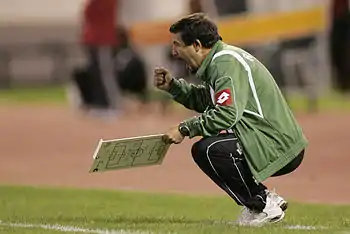
Since 1949, Raja has always had a reputation of being a team of artists playing to have fun and enjoy The Beautiful Game. Père Jégo gives Wydad a European style, organized and efficient, based on physicality and tactics around one striker. The coach changes his mind when he came to Raja, and affirms that “the physiological capacities of Moroccans are closer to those of South Americans than Europeans. It's more logical to be inspired by it ”. More than titles, he offered the club something more precious: the 'Rajaoui game', collective and spectacular, based on short passes and Push and runs. He takes as a model South American football, which he discovered ans studied during his travels. Since then, the club's academy make sure to instill this ideology of football to all the players, from youngsters to professionals.
During many years, the team was mainly focused on playing rather than winning, players must develop an elegant and creative football, supporters does not come to see defensive play but fast and skillful game. As a result, Raja did not win any national trophy until the 1974 Throne Cup, the first league title was gained in 1988, which was quickly followed by the Champions League in 1989, not to mention the famous 1959–60 championship refused to Raja and the 2 Throne cups finals lost in 1965 and 1968. This entertaining value of the game lead the supporters to call their team "Raja lfraja" (Raja of the show).
The appearances on the international circuit had gained the attention of many football experts. Just after winning the 1997 Champions League, Raja received an invitation from Marcello Lippi's Juventus F.C. to play a preparation match at Palermo.
This style of play led to Raja gaining the support and encouragement of 40,000 Brazilians at Estádio do Morumbi in São Paulo, during its historic performance in the 2000 Club World Cup against Vicente Del Bosque's Real Madrid.[6]
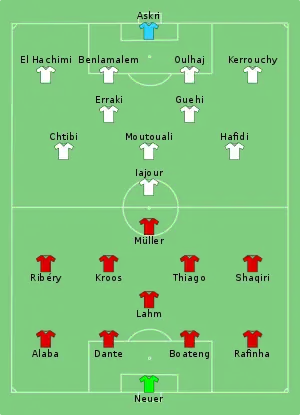
Mascot
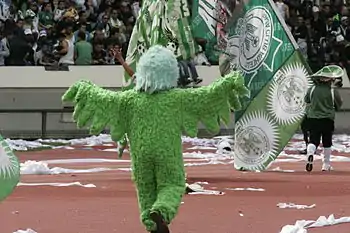
During a tough period marked by the French occupation of Morocco and by the resistance, the eagle represented for the founders the strong, prestigious and combative raptor.[7] The animal's charisma is very representative of the history of the club, Raja was able to fly over the opponents despite the constraints. As Père Jégo wanted, the mythic figure of the history of the club, the eagle has been the club's emblem and mascot since its creation.
Honours
Raja's first trophy was the Throne Cup, in 1974. In 1988, the club won its first League title, while the twelfth and most recent was in 2020. The club's most successful decade was the 2000s, when the club won four League titles, two Throne Cups, one CAF Cup, one Super Cup, and one Arab Champions Cup.
Raja CA are the most successful Moroccan club in international football with eight trophies, having won the African Cup/CAF Champions League, CAF's premier club competition, three times, a national record. They also hold the Moroccan record of two wins in the CAF Cup/Confederation Cup and CAF Super Cup ,CAF's secondary and tertiary club competitions.
The team have played 27 finals in major competitions and won 30 trophies, including 20 national titles and 10 international titles. Raja was ranked by FIFA in 10th place in the classification of the best clubs in the world after the team's performances at the 2000 Clubs World Cup.
Domestic competitions
- Botola: 12
Regional competitions
- Winner: 2015
Friendly competitions
- International Friendship Abha Cup: 1
- Winner: 2004[8]
- Runner-up: 2001
- Arab Summer Cup: 1
- Winner: 2007
- Ahmed Antifi Tournament: 2
- Winner: 2009, 2016
- Runner-up: 2010
2000 FIFA Club World Cup
Raja CA is the first Arab and African team to participate in the Club World Cup. They competed in the first edition that took place in 2000 in Brazil. The competition allowed them to confront some of the great football teams from around the world. Raja was eliminated in the first round after three losses against Corinthians (0-2), Al Nassr FC (3-4) and Real Madrid (2-3), this last game where, despite the defeat, Raja made an amazing performance against the club of the 20th century, and lost on a late goal by Geremi, and was highly acclaimed by the public present at the Morumbi Stadium.
2013 FIFA Club World Cup
Raja CA became the second club to reach the FIFA Club World final as the host nation's national champions, after Brazilian club Corinthians, and the first under the current seven-club format since the 2007 edition, as they defeated Auckland City FC then C.F. Monterrey and Atlético Mineiro (3–1) at the semi-final of the 2013 FIFA Club World Cup.[9]
Performance in CAF competitions
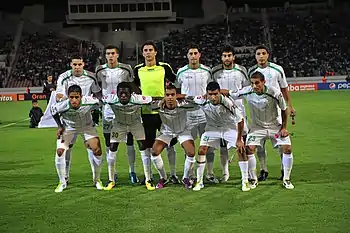
|
|
Records
• Raja is the only Moroccan club to have occupied a place in the annual ranking of the best 10 clubs in the world [ref. required] established by the International Federation of Association Football (FIFA) in 2000.
• Following its excellent performances at the 2000 Club World Cup, Raja is in 10th place in the ranking, at the head of African clubs. He was also the African champion this year by winning his third Champions League.
• In 2004, Raja was included in an official ranking organized by FIFA, on the occasion of its hundred years of existence, and which brings together the best 100 football clubs in the world, while counting national and international titles.
• The green eagles were ranked 77 in the world, the Raja was also the only Maghrebian club to enter this top 100.
• In 2018, a ranking of the best African clubs of all time was established by the French website The 10 best, Raja CA is ranked in 4th place.
• First club to win the CAF Champions League from its first participation.
• Only Arab and North African club to reach the final of the Club World Cup and the second in Africa (in 2013). First African and Arab team to qualify for the FIFA Club World Cup (2000).
• First team to win an African Supercup organized outside the African continent "Doha Edition 2019".
•In African competitions, Raja has conceded no home defeat at Stade Mohammed V since 2005.
•The highest African audience ratings record was reached in the 2013 Club World Cup semi-final between Raja and Atlético Mineiro, with some 650 million listeners and viewers worldwide whole.
•Most goals scored by a team in a single African competition: 34 Goals (Confederation Cup 2018). Biggest victory of a Moroccan team in African competitions: 10–1 against Tourbillon FC (CAF Champions League 2011).
Communication and partners
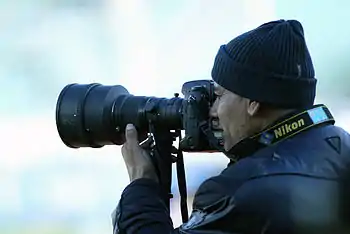
On 23 October 2009, the first edition of the bi-monthly press support "Journal du Raja" was published. This launch takes place within the framework of a strategy of creation of a media pole offering a priviliged channel of information and communication with the supporters.
The clubs says that the magazine "will also allow information to be distilled from credible sources to the public and to the journalists about the daily life and the matches of the team, through reports, interviews, technical-tactical analyzes and exclusive images."
In 2012, the club launched 'Raja TV' channel, which broadcasts exclusive team videos, matches and training sessions as well as press conferences and 'behind the scenes' reports, that's available on YouTube. In 2016 'Raja Radio' was launched, broadcast on the internet, to provide the latest information of the club. A program called 'Raja Café' was broadcast live every Monday on Radio Mars and another program called 'La Voix du Raja' is aired on Radio MFM.
On 16 September 2019, Raja launched 'Radio Raja' project in order to bring the public closer to news, events and developments concerning their club. The radio has a list of four shows:
• Père Jégo: Discussion of club throughout the week.
• L'oulad: Invitation of current team players to bring them closer to the supporters.
• La Grande Storia: Invitation of former players and managers to talk about their careers within the club.
• Tribune d'honneur : a program that welcomes members of the club committee.
These shows are first broadcast live on Facebook, before being rebroadcast on the club's official channels on digital platforms YouTube, Spotify and iTunes.
On social networks, Rajaouis are very active, there are hundreds of fan pages and channels on all social networks, reporting various photos, videos and news of the club.
Raja also have official accounts on several social networks, all of which are the most followed for a sports club in the country and in Maghreb:
• Facebook page with +4.8 million likes.
• Instagram account with +1.5 million followers.
• YouTube channel with +400,000 subscribers and +44,000,000 views.
Theses numbers makes Raja the most followed team in Morocco and in the Maghreb, and the 65th in the world according to Digital Sports Media.
Presidents

| No | Period | Name | From | To |
|---|---|---|---|---|
| 1 | 1st | 20 March 1949 | September 1956 | |
| 2 | 1st | September 1949 | 1956 | |
| 3 | 1st | 1956 | 1958 | |
| 4 | 1st | 1958 | 1961 | |
| 5 | 1st | 1961 | 1968 | |
| 6 | 1st | 1968 | 1970 | |
| 7 | 1st | 1970 | 1972 | |
| 8 | 1st | 1972 | 1974 | |
| 9 | 1st | 1974 | 1976 | |
| 10 | 1st | 1976 | 1981 | |
| 11 | 1st | 1981 | 1984 | |
| 12 | 1st | 1984 | 1985 | |
| 13 | 1st | 1985 | 1989 | |
| 14 | 1st | 1989 | 1990 | |
| 15 | 1st | 1990 | 1992 | |
| 16 | 1st | 1992 | 1998 | |
| 17 | 1st | 1998 | 2 August 2002 | |
| 18 | 1st | 2 August 2002 | 14 July 2004 | |
| 19 | 2nd | 14 July 2004 | 12 July 2007 | |
| 20 | 2nd | 12 July 2007 | 4 June 2010 | |
| 21 | 2nd | 4 June 2010 | 10 May 2012 | |
| 22 | 1st | 7 June 2012 | 20 June 2016 | |
| 23 | 1st | 20 June 2016 | 13 April 2018 | |
| 24 | 2nd | 13 Avril 2018 | 13 September 2018 | |
| 25 | 1st | 13 September 2018 | 14 December 2020 | |
| 26 | 1st | 14 December 2020 | - |
Managers
 Pére Jègo : the manager, the men and the legend of Raja
Pére Jègo : the manager, the men and the legend of Raja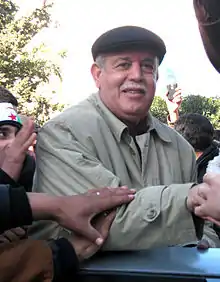
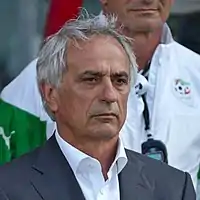


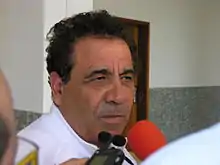
|
|
|
Current squad
- As of 24 October 2020
Note: Flags indicate national team as defined under FIFA eligibility rules. Players may hold more than one non-FIFA nationality.
|
|
Current technical staff
- As of 24 October 2020
| Position | Staff |
|---|---|
| Head coach | |
| 1st Assistant coach | |
| 2nd Assistant coach | |
| Goalkeepers coach | |
| Fitness coach | |
| Doctor | |
| Match delegate |
Notable players
Goalscorers by season
| Season | Players | Goals |
|---|---|---|
| 2001–02 | – | |
| 2002–03 | 17 | |
| 2003–04 | 13 | |
| 2004–05 | 20 | |
| 2005–06 | 12 | |
| 2006–07 | 17 | |
| 2007–08 | 9 | |
| 2008–09 | 10 | |
| 2009–10 | 13 | |
| 2010–11 | 8 | |
| 2011–12 | 10 | |
| 2012–13 | 12 | |
| 2013–14 | 16 | |
| 2014–15 | 9 | |
| 2015–16 | 12 | |
| 2016–17 | 10 | |
| 2017–18 | 25 | |
| 2018–19 | 26 | |
| 2019-20 | 14 |
Transfers
| Ran | Players | Indemnity | Years | Transfer | References | ||
|---|---|---|---|---|---|---|---|
| 1st | 1.80 M€ | 1998 | |||||
| 2nd | 1.10 M€ | 2016 | |||||
| 3rd | 1.00 M€ | 2007 | |||||
| 4th | 1.00 M€ | 2008 | |||||
| 5th | 1.00 M€ | 2014 | |||||
| 6th | 0.80 M€ | 2018 | |||||
Club Logos and identity
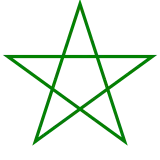
Colors and kits
The colors of the team are green and white. The green color was chosen by the club's founders because it symbolizes hope and growth. Green is also considered the traditional color of Islam. On top of that, green is one of the colors of the Moroccan flag. White is the color of the hometown of the club, Casablanca These colors were used since the team's first matches in 1949.
The jersey of the Greens was long made by the German Adidas, during a period from 1968 to 1980, where he was replaced by Puma until 1995. In 1990, Raja entered into his first sponsorship deal with Chimicolor, making him the first Moroccan club to display a sponsor on his jersey. Comes after that the Moroccan bank of Africa and the East (BMAO) and ODEP 'known today as MarsaMaroc'. From 1995 to 1999, the club is sponsored by Danone and Lavazza for a year, but the club changes equipment manufacturer each season, and sees succeed successively Adidas, Uhlsport, Umbro and Adidas another time. After his victory in the 1999 CAF Champions League, Raja a contract Hummel valid until 2002, the jersey will be sponsored during this period by Western Union, Fiat, Café ASTA and Coca-Cola, In 2001, Raja signed a contract with the French sports management company Transatlas Sports Management (TSM) which has made Raja one of the first clubs in Africa to have a commission for marketing and advertising. When the Hummel contract expires, the club gives his jersey to the Italian Kappa for a period of 6 years, and also signed with Siera who remains the main sponsor until now. Then, Lotto is the equipment supplier of the club from 2008 to 2013, then Adidas takes over again until 2017. Since 2017, it is the Italian Legea.
| Home kits | ||||||||||||||||||||||||||||||||
|---|---|---|---|---|---|---|---|---|---|---|---|---|---|---|---|---|---|---|---|---|---|---|---|---|---|---|---|---|---|---|---|---|
|
Mascot
The eagle meanwhile, in a period marked by the colonization of the country and the resistance, represented for the founders the strong, prestigious and combative bird. The charisma of the animal is very representative of the history of the club, Raja was able to fly over his opponents despite difficulties. He naturally stands out as one of the club's emblems and mascots for many years.
Stars
Many football clubs around the world sport stars on their jerseys, and Raja is no exception. The jerseys of Raja have four golden stars. Each of his stars represents one of his victories in African or national competition. The first three (at the bottom of the logo) symbolize his three cups in the CAF Champions League of 1989, 1997 and 1999; the fourth (the biggest at the top of the logo) was added in 2011 following the tenth win in Botola Pro.
Infrastructure
Mohamed V Stadium (D'honor)
Mohamed V Stadium was called the Marcel Cerdan stadium in 1955–56 and the Honnor stadium in 1956–81. It was inaugurated on 6 March 1955 and it knew two renovations in 1981 and 2000. It is the official stadium for the Raja Club Athletic and also for Wydad Club Athletic.
Mohamed V Stadium is part of a large sports complex in the heart of the city of Casablanca, specifically in the upscale neighbourhood of Maârif. It has today a capacity of 67,000 spectators (more than 80,000 in 2000), not counting the North and South turns that have no seats, but where environments are warmer, and in 1997 it beat a record of 110,000 spectators in a match of Morocco against Ghana. The south turn or "Magana" (the clock in Moroccan dialect) ended up with the main groups of Raja Casablanca fans. In 2007, the stadium was equipped with a semi-artificial turf which is acceptable under international standards. As well, the seats in the stands, the sanitary facilities and athletics track were all replaced.
| Former names | Stade Marcel Cerdan (1955–56) Stade d'Honneur (1956–1981) |
|---|---|
| Location | Rue al-Azrak Ahmed, Maârif, Casablanca, Morocco |
| Owner | City of Casablanca |
| Capacity | 45,000 |
| Record attendance | 100,000 |
| Surface | Grass |
| Construction | |
| Opened | 6 March 1955 |
| Renovated | July 2015 |
| Tenants | |
| Morocco national football team Wydad Casablanca Raja Casablanca | |
Sport facilities
Sports facilities available to Raja Casablanca:
- Raja Oasis Sports Complex: Raja Oasis ports Centre is where Raja Casablanca trains. It houses the club's training facility which includes three football fields, a gym, a boarding school for the training center, a restaurant group ...[10]
- Raja Academy
- Complex Tessema
- Roches Noires Stadium
- Kahrama Stadium
Supporters

The southern part of Complexe Mohamed V is fully occupied by supporters (ultras) of the club; it is the famous area called LMAGANA. Four sectors of this area of the stadium can be distinguished:
- The official gallery devoted in part to the leaders and members of the club.
- The Tribune side, covered with green seats and a rostrum.
- The Virage Sud, blank marked by the presence of a mythical scoreboard.
- The Bleachers, covered with green seats and free forum.
In 2013, according to a ranking that was done by a football website, the supporters of Raja Casablanca are among the world's 10 best football supporters, reaching fourth place. In 2014, after the amazing show of ultras of the club in the FIFA Club World Cup when Raja Casablanca had reached the final, they occupied first place in Africa and third in the whole world according to an annual ranking by Ultras World.
The supporters of Raja Casablanca are distributed in 2 ultras:
- Ultras Green-Boys 05 (First Ultras In Morocco)
- Ultras Eagles 06
Foundation
Through its foundation created in 2013, Raja carries out actions of general interest dedicated to children and young people to support them towards success, make them discover sport and its values and finally participate in the realization of their dreams by supporting d 'other associations. To better promote this foundation, Raja decided to display the Raja Foundation logo on the official jersey of its professional team from 20 February 2013 when it met against Raja Beni Mellal at the Mohamed V Complex.
In this same perspective, in 2007 Raja became the sponsor of the association of SOS Children's Villages (founded in 1949) in Morocco. By this agreement, the club opens the doors of its structures by authorizing the enrollment of a significant number of children and adolescents in its various sports disciplines and by providing them with the uniform and equipment necessary for the practice of their favorite sport.
Rivalries
Casablanca Derby
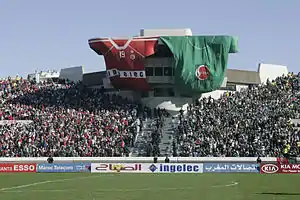
The Casablanca derby (Arabic: الدربي البيضاوي) is a derby between the Moroccan football clubs Raja and Wydad. Matches are played in the Stade Mohamed V, often containing a fierce and vibrant crowd.
The Casablanca derby has extensive national media coverage and is a topic of debate for several days before and after the match between the fans of both clubs, whether in the streets, schools or workplace.
The first match between the two rivals was in 1956 in which Raja won 1–0.
In 1978, Raja players withdrew from the match against Wydad during the second half after their goalkeeper received a red card and a penalty was awarded.[12]
In 1996, Raja won 5–1 in the quarter-finals of the 1995–96 Coupe du Trône; this score is the highest between the two rivals.
- As of 24 September 2020[13]
| Matches | Wins | Draws | Goals | |||
|---|---|---|---|---|---|---|
| R | W | R | W | |||
| Botola | 128 | 35 | 31 | 62 | 108 | 99 |
| Throne Cup | 14 | 6 | 5 | 3 | 19 | 15 |
| All competitions | 142 | 41 | 36 | 65 | 127 | 114 |
| Independence Cup | 1 | 0 | 1 | 0 | 0 | 1 |
| All matches | 143 | 41 | 37 | 65 | 127 | 115 |
The Classico
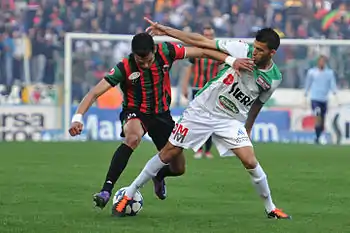
Classic match between Raja CA and ASFAR. It is considered one of the greatest games of Botola after the derby, some times he even managed to overtake him. The rivalry between the two clubs does not lack history, there was a rivalry in the 1960s, after the Botola controversy of 1959–1960, where the Royal Moroccan Football Federation (Frmf) decided to take the title away from Raja, which was tied with ASFAR and KAC in points, but which exceeded them in terms of difference in goals. the rivalry continues with spectacular matches whether in Rabat or Casablanca in the coming years
In the 1980s, both teams were at their peak where ASFAR were crowned champions of Africa in 1985 and Raja in 1989, and they could be entertained by Moroccans with high level matches.
In the 1990s, this rivalry experienced a big decline because of the crushing superiority of Raja, which widely dominated all his rivals during this period, it is in the 2000s, exactly in 2005 that the Raja-ASFAR rivalry took a new breath and regained a lot of intensity, when the ASFAR have gained the title after beating Raja at Mohammed V stadium in the last day of the Botola. This match is a turning point in the history of the rivalry where it will take on a more intense dimension, where the hooligans of both teams will also increase the aggravation of tensions between the two big clubs.
In 2013, a season similar to that of 2005, but this time it is the consecration of Raja as champion of Morocco and the cup of the throne, and ASFAR, vice champion of the two competitions, the club more dream did not win the Moroccan classic
Sponsors
| Period | Kit manufacturer | Shirt partner |
|---|---|---|
| 1949–1968 | none | none |
| 1968–1980 | Adidas | |
| 1980–1987 | Puma | |
| 1987–1988 | Chimicolor | |
| 1988–1989 | BMAO ODEP | |
| 1989–1990 | Uhlsport | |
| 1990–1995 | Puma | |
| 1995–1996 | Adidas | Danone |
| 1996–1997 | Uhlsport | |
| 1997–1998 | Umbro | |
| 1998–1999 | Adidas | Lavazza |
| 1999–2000 | Hummel | Western Union Fiat et Coca-Cola |
| 2000–2001 | Coca-Cola | |
| 2001–2002 | Café ASTA Tube et Profil | |
| 2002–2003 | Kappa | Siera Tube et Profil |
| 2003–2008 | Siera | |
| 2008–2013 | Lotto | |
| 2013–2017 | Adidas | |
| 2017– | Legea |
Actual sponsors
- Transatlas Sport Management
- Siera
- Atlanta Assurance
- Legea
- Maroc Telecom
- Hyundai
- Marsa Maroc
- Nor'Dar
- Newmerique
- Transatlas Sport Management
- Infinix Mobile
- Koutoubia
- Junkers
- Prodec
- Odyssée
References
- https://fr.fifa.com/news/-789982
- https://www.lesiteinfo.com/sport/casablanca-liesse-a-derb-sultan-apres-le-sacre-du-raja-video/
- https://www.h24info.ma/sport/football/global-digital-ranking-le-raja-club-le-plus-populaire-du-maroc/
- https://m.le360.ma/sport//football/le-raja-club-africain-le-plus-populaire-64979
- https://www.h24info.ma/sport/football/le-derby-wydad-vs-raja-lun-des-meilleurs-du-monde-classement/
- Youtube Video: Raja vs Real Madrid Cup Club World Cup in 2000
- http://www.pure-spirit.com/more-animal-symbolism/629-eaglesymbolism#:~:text=Eagle%20conveys%20the%20powers%20and,higher%20than%20any%20other%20bird.&text=If%20eagle%20has%20appeared%2C%20it,of%20honesty%20and%20truthful%20principles.
- "International Friendship Cup 8 2004". Goalzz.com. Retrieved 20 July 2014.
- "Raja Casablanca 3 Atletico Mineiro 1". BBC Sport. 18 December 2013. Retrieved 19 December 2013.
- Training Center Raja Casablanca Archived 15 July 2011 at the Wayback Machine
- http://moroccantimes.com/2016/03/18719/18719
- "الرجاء والوداد: تاريخ وأبرز 4 أحداث الديربي البيضاوي المغربي الشهير". Sport360 (in Arabic). 26 November 2016. Retrieved 10 December 2018.
- Derby Casablanca: Les résultats. wydad-raja.com. Retrieved 27 August 2017
- Raja Casablanca relishing underdog run to Club World Cup final – Sports Illustrated, 20 December 2013
.jpg.webp)
